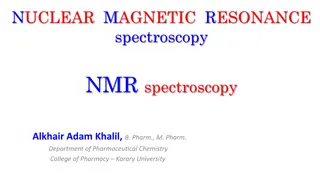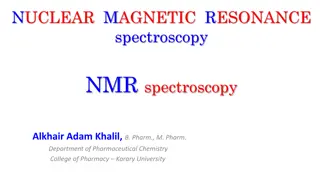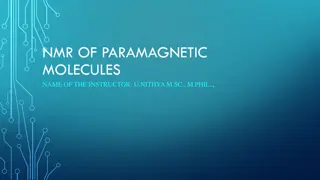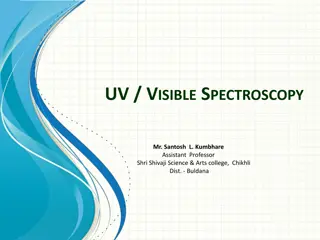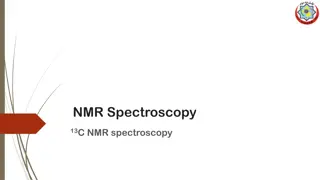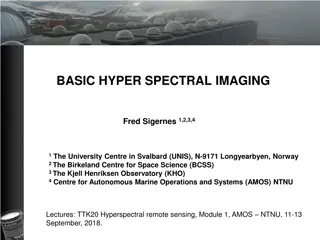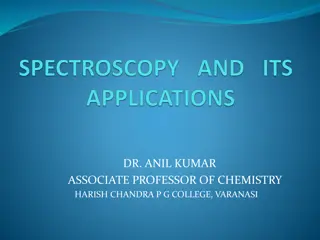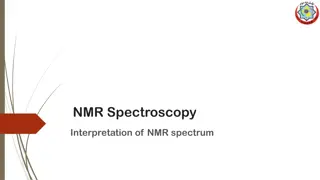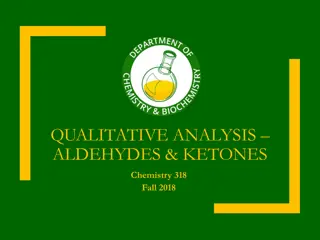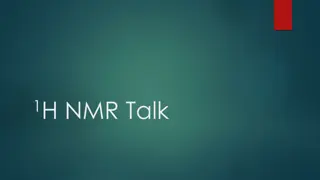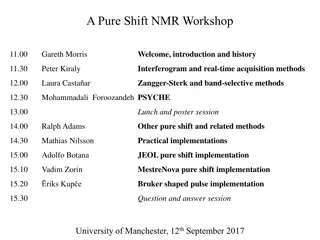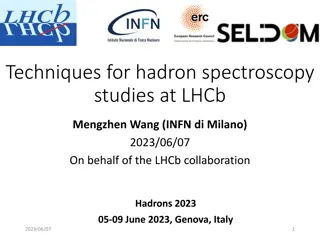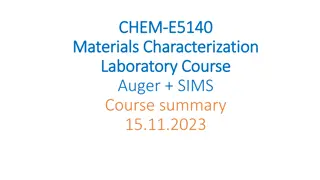NMR Spectroscopy Lecture Highlights and Questions
Explore the world of NMR spectroscopy through a lecture covering theory, instrumentation, and the effects of the environment on spectra. Delve into questions on magnetic field drift, spin states, sensitivity, peak width resolution, and more. Discover the intricate details of modern NMRs and the impact of chemical environments on nuclei, offering insights into elemental analysis using NMR techniques.
Download Presentation

Please find below an Image/Link to download the presentation.
The content on the website is provided AS IS for your information and personal use only. It may not be sold, licensed, or shared on other websites without obtaining consent from the author.If you encounter any issues during the download, it is possible that the publisher has removed the file from their server.
You are allowed to download the files provided on this website for personal or commercial use, subject to the condition that they are used lawfully. All files are the property of their respective owners.
The content on the website is provided AS IS for your information and personal use only. It may not be sold, licensed, or shared on other websites without obtaining consent from the author.
E N D
Presentation Transcript
Announcements Homework due 4/13 (2 problems) Quiz also on 4/13 4/13 Lecture may be guest lecture (Dr. Miller- Schulze on mass spectrometry) Today s Lecture NMR Spectroscopy (Rubinson & Rubinson Ch. 11) Theory Effect of Environment on Spectra Spin-Spin Coupling Instrumentation (if time)
NMR Spectrometry Some Questions Modern NMRs continuously monitor 2H absorbance to account for magnetic field drift in the lock unit. The frequency of the 2H signal is observed to drift by 30Hz over 1 hour. Given the magnetic field H0= 8.45 T, (2H) = 8.22 x 107radian T-1s-1and (1H) = 2.68 x 108radian T-1s-1, calculate the magnetic field drift and the drift in the 1H frequency in an hour. 17O has an I value of 5/2. How many spin states will it have? Explain why sensitivity is increased by going to a larger magnetic field. Will increasing the temperature increase or decrease NMR sensitivity (assuming it has no effect on relaxation processes)? 1. 2. 3. 4.
NMR Spectrometry Another Question 1. An 1H nucleus relaxes with a characteristic time of 380 ms. What is the narrowest peak width expected in a spectrum? If this resolution can just be achieved with the instrument at an 1H frequency of 300 MHz, what would be the resolution of the NMR instrument?
NMR Spectrometry Effect of Environment on Nuclei Use of NMR for elemental analysis (spectrum shown previously) is of limited use However, nuclei of given elements also can be affected by their chemical environment (although these effects are very small compared to element element comparisons) Both electrons surrounding the nucleus as well as less confined electrons in molecules can affect the magnetic field at the nucleus (our previous assumption that Hnucleus = H0= HAppliedis no longer valid)
NMR Spectrometry Effect of Environment on Nuclei Use of NMR for elemental analysis (spectrum shown previously) is of limited use However, nuclei of given elements also can be affected by their chemical environment (although these effects are very small compared to element element comparisons) Both electrons surrounding the nucleus as well as less confined electrons in molecules can affect the magnetic field at the nucleus (our previous assumption that Hnucleus= H0= HApplied is no longer valid)
NMR Spectrometry Effect of Environment on Nuclei Simple example of effect on 1H nuclei electrons) applied magnetic field induces electron circulation electron circulation induces magnetic field Induced magnetic field shields nucleus from HApplied(note H0= const.) H0< HApplied (upfield shift) HApplied Hinduced H0 = HApplied 1H+(g) (no effects of Hshielding 1H+ 1H H0 e- 1H (g) 1H+ (g) H0 = HApplied 1H (g) HApplied
NMR Spectrometry Effect of Environment on Nuclei More complicated example: CH3CH2CH2Cl all Hs shielded by C H bond electrons shielding from electrons weaker for Hs nearer to Cl due to electron withdrawing nature of Cl term for shift for Hs closer to Cl is deshielding Low Resolution Spectrum (no splitting shown) Note on scale: - neither T nor Hz typically used for x- axis Instead: ppm = ( sample standard)*106/ H
NMR Spectrometry Magnetic Anisotropy Besides effects from electron withdrawing (or electron supplying), electron currents outside of the bonds can affect H0 This can occur from the induction of larger scale electron circulations Example: benzene ring ( ~ 7 to 8 ppm much greater than expected based on local electron density) p-orbitals H H H H e- H H HApplied electrons circulate This induces magnetic field in same direction as Happlied Effect is the same as deshielding and similar electron currents can originate in alkenes and alkynes
NMR Spectrometry Other Effects on Spectra Number of peaks (equal to number of equivalent nuclei) Peak position (discussed already) Peak area Proportional to number of nuclei of given type/environment (for 1H, not typical for 13C) Given by integration Peak width (affected by relaxation) Multiplets (next slide)
NMR Spectrometry Spin Spin Coupling We have seen that both H bond electrons and neighboring bond electrons affect H0. In addition, neighboring NMR active nuclei affect H0. Example: CHCl2CH2Br CH2Br protons are affected by spin of CHCl2 proton (so split into two peaks from spin up and spin down CHCl2 proton) CHCl2 proton is affected by two CH2Br protons (three possibilites: two spins up, spins up and down, two spins down) Spin up + spin down twice as likely because either nuclei can be spin up Low Resolution -CH2Br -CHCl2 H0 Opposing spins H0
NMR Spectrometry Spin Spin Coupling Example: CHCl2CH2Br Energy view of spin-spin splitting CH2Br nuclei can be aligned with or against the magnet Each CH2Br state is slightly higher or lower depending on state of CHCl2 When all spins are up , the energy is the lowest The unaligned CH2Br (1H) is similarly affected Transitions only involve the CH2Br nuclei (see plot) the CHCl2nuclei can t flip Splitting of CHCl2 by CH2Br is similar CH2Br CHCl2 E Down- field coupling Ho Up-field coupling
NMR Spectrometry Spin Spin Coupling Both homonuclear (1H 1H) and heteronuclear (1H 19F) splitting can occur (although homonuclear splitting is more common) Nuclei must be close enough for magnetic fields to be observable (normally 3 bonds or less for 1H 1H) The number of split peaks = n + 1 for n neighboring equivalent nuclei (only for I = nuclei causing splitting) The distance between split peaks is constant in Hz (not ppm) and is the same for both nuclei (e.g. splitting constant for A proton caused by B proton will be the same for both A and B protons) In the case of one set of equivalent nuclei causing splitting, you should be able to predict the pattern caused If more than one set of nuclei cause splitting, the result is complex (although you can predict number of peaks if splitting constants are similar)
NMR Spectrometry Interpretation Examples Predict Spectra (# equivalent peak, relative locations of peaks, relative peak areas, and splitting patterns) for the following compounds: CH3CHBrCH3 (CH3)2CHCOCH3 CH3CH2OCH2F (CH3)2C=CHCH3 CHDClOCH3 CH3CH2CHBr2 ClCH2CHClF What type of groups caused this:
NMR Spectrometry Instrumentation 2.35 T Magnet (100 MHz) Magnet Needs a) high field strength and b) very homogeneous field Why high field strength? greater sensitivity (N*/N0 lower with higher B0) easier to resolve overlapping peaks ( const. in ppm, J in Hz) TMS overlapping peak of ethyl group J = 7 Hz = 0.14 ppm (14 Hz) 11.8 T Magnet (500 MHz) no longer overlapping J = 7 Hz = 0.14 ppm = 70 Hz
NMR Spectrometry Instrumentation Magnet (cont.) Why homogeneous field? needed to obtain high resolution example, to resolve 2 Hz splitting in a 600 MHz instrument, a resolution required is 600,000,000/2 = 3 x 108; so magnetic field (H0) must vary by less than 1 part in 300,000,000 over the region where the sample is detected done by shims (small electromagnets in which current is varied) and spinning sample (to reduce localized inhomongenieties)
NMR Spectrometry Instrumentation Light Source Radio waves produced by RF AC current with antenna Continuous in CW (continuous wave) instruments Pulsed in FT (Fourier Transform) Instruments Sample Typically contains: active nuclei, sample matrix, and deuterated solvents (for proton NMR) Deuterated solvent used to reduce interference and to use lock (CW NMR to locate frequency based on D signal) Light Detector same antenna producing light (at least in FT NMR)


